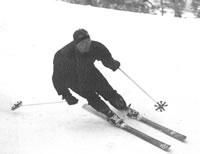Bunny Bass - Robert Bunny Bass, ski boot pioneer
Key figure in ski boot history -- and a founder of Sugarloaf.
Robert N. "Bunny" Bass, 89, died Friday, Oct. 27, 2006, in Falmouth Maine.
Bunny Bass had a busy decade in the 1950s. He spent it running his family’s boot and shoe business, helping to launch Ski Industries America (SIA), and helping to found Sugarloaf Mountain.
Bass was born Aug. 23, 1917, son of John R. and Alice Ness Bass, and grandson of George Henry Bass, who founded the G.H. Bass shoe factory in Wilton, Me. in 1876. Bob’s older brother George dubbed him Bunny for the way he looked as a toddler in Dr. Denton’s one-piece pyjamas. The name stuck with him for life, even onto the hockey rink and football field at Deerfield Academy, where he was an all-state tackle.
The Bass boys were taught to ski by their uncle Willard Bass, a polymath who skied for Bowdoin College and went on to take masters degrees in math and chemistry at Harvard by age 20. After teaching in Chicago for a few years, Willard returned to Wilton to help run the shoe company, and there he launched the first ski boot in 1934 by putting a square toe on one of the factory’s mainstays, a stiff logger’s boot. The boot was supplied to American athletes competing at the 1936 Olympics, in separate versions for jumping, cross country and downhill skiing.
Bunny graduated Bowdoin in 1940, and went on to Harvard Business School. The following year he was one of about 250 HBS students to enroll in the Navy’s Officer Candidate School at Dartmouth. Pearl Harbor found him working in the Lend-Lease office as a liaison to the Russian, French and British navies. He then served as a gunnery officer on the USS Phoenix, a light cruiser operating with the Seventh Fleet in the Philippines and Papua New Guinea. “We were a lucky ship,” he recalled. “We worked with the Australian Navy covering amphibious landings, and had plenty of action, but in two years we lost only one crewman in combat.” At war’s end, Bass declined promotion to lieutenant commander and returned to the shoe factory, where George was the president and production chief. Bunny served as treasurer and head of sales. In 1948 he married Martha Lord of Augusta, Me.
In 1950, Bunny got involved with the Maine Ski Council, which was trying to develop a ski area at remote Mt. Katahdin. “Amos Winter directed us to Sugarloaf, pointing out that it was a lot more accessible and had a perfect exposure and pitch for alpine skiing,” Bass said. “Sel Hannah came over from New Hampshire to help lay out the trail system, and we cut trails beginning that year. We bought a T-bar from Ernst Constam in 1952.” Bunny served as president of the Sugarloaf Mountain Corp. for ten years.
By this time, G.H. Bass was one of the leading suppliers to the nascent American ski industry, selling about 5000 pairs of ski boots each winter. The company’s chief rival was Beconta Corp., under Jim Woolner and Karl Wallach, who imported Nordica. In 1953, Bass joined with Woolner, attorney Jim Weinstein, Henry Barreca and a few others to found the trade association later dubbed Ski Industries America (SIA). He was SIA’s second president.
Partly through the success of SIA, G.H. Bass found itself competing with a flood of good ski boots from Europe. Bass began importing European-made boots – a good example was the Bass Internationale, made by Munari. Later, Bass became the U.S. distributor for Raichle boots. By the 1968 it was clear that the future belonged to plastic boots, so Bass bought the Rosemount factory in Minnesota, and also took on distribution of the new Hexcel ski.
Bunny served as executive director of the Maine Society of CPAs until retiring with Martha to Portland, Me.

